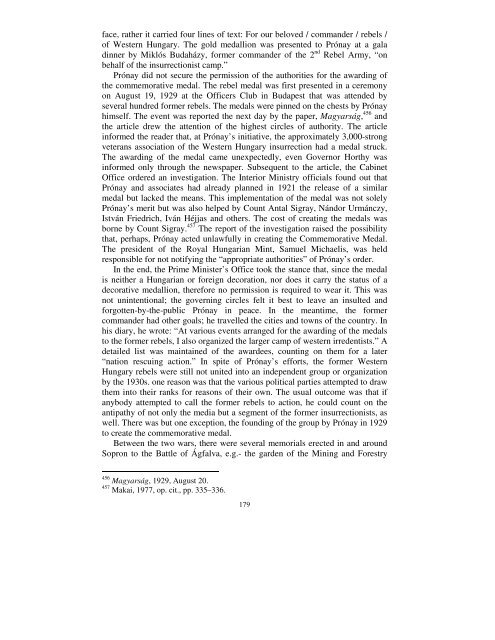The Fate of Western Hungary 1918-1921 - Corvinus Library ...
The Fate of Western Hungary 1918-1921 - Corvinus Library ...
The Fate of Western Hungary 1918-1921 - Corvinus Library ...
You also want an ePaper? Increase the reach of your titles
YUMPU automatically turns print PDFs into web optimized ePapers that Google loves.
face, rather it carried four lines <strong>of</strong> text: For our beloved / commander / rebels /<br />
<strong>of</strong> <strong>Western</strong> <strong>Hungary</strong>. <strong>The</strong> gold medallion was presented to Prónay at a gala<br />
dinner by Miklós Budaházy, former commander <strong>of</strong> the 2 nd Rebel Army, “on<br />
behalf <strong>of</strong> the insurrectionist camp.”<br />
Prónay did not secure the permission <strong>of</strong> the authorities for the awarding <strong>of</strong><br />
the commemorative medal. <strong>The</strong> rebel medal was first presented in a ceremony<br />
on August 19, 1929 at the Officers Club in Budapest that was attended by<br />
several hundred former rebels. <strong>The</strong> medals were pinned on the chests by Prónay<br />
himself. <strong>The</strong> event was reported the next day by the paper, Magyarság, 456 and<br />
the article drew the attention <strong>of</strong> the highest circles <strong>of</strong> authority. <strong>The</strong> article<br />
informed the reader that, at Prónay’s initiative, the approximately 3,000-strong<br />
veterans association <strong>of</strong> the <strong>Western</strong> <strong>Hungary</strong> insurrection had a medal struck.<br />
<strong>The</strong> awarding <strong>of</strong> the medal came unexpectedly, even Governor Horthy was<br />
informed only through the newspaper. Subsequent to the article, the Cabinet<br />
Office ordered an investigation. <strong>The</strong> Interior Ministry <strong>of</strong>ficials found out that<br />
Prónay and associates had already planned in <strong>1921</strong> the release <strong>of</strong> a similar<br />
medal but lacked the means. This implementation <strong>of</strong> the medal was not solely<br />
Prónay’s merit but was also helped by Count Antal Sigray, Nándor Urmánczy,<br />
István Friedrich, Iván Héjjas and others. <strong>The</strong> cost <strong>of</strong> creating the medals was<br />
borne by Count Sigray. 457 <strong>The</strong> report <strong>of</strong> the investigation raised the possibility<br />
that, perhaps, Prónay acted unlawfully in creating the Commemorative Medal.<br />
<strong>The</strong> president <strong>of</strong> the Royal Hungarian Mint, Samuel Michaelis, was held<br />
responsible for not notifying the “appropriate authorities” <strong>of</strong> Prónay’s order.<br />
In the end, the Prime Minister’s Office took the stance that, since the medal<br />
is neither a Hungarian or foreign decoration, nor does it carry the status <strong>of</strong> a<br />
decorative medallion, therefore no permission is required to wear it. This was<br />
not unintentional; the governing circles felt it best to leave an insulted and<br />
forgotten-by-the-public Prónay in peace. In the meantime, the former<br />
commander had other goals; he travelled the cities and towns <strong>of</strong> the country. In<br />
his diary, he wrote: “At various events arranged for the awarding <strong>of</strong> the medals<br />
to the former rebels, I also organized the larger camp <strong>of</strong> western irredentists.” A<br />
detailed list was maintained <strong>of</strong> the awardees, counting on them for a later<br />
“nation rescuing action.” In spite <strong>of</strong> Prónay’s efforts, the former <strong>Western</strong><br />
<strong>Hungary</strong> rebels were still not united into an independent group or organization<br />
by the 1930s. one reason was that the various political parties attempted to draw<br />
them into their ranks for reasons <strong>of</strong> their own. <strong>The</strong> usual outcome was that if<br />
anybody attempted to call the former rebels to action, he could count on the<br />
antipathy <strong>of</strong> not only the media but a segment <strong>of</strong> the former insurrectionists, as<br />
well. <strong>The</strong>re was but one exception, the founding <strong>of</strong> the group by Prónay in 1929<br />
to create the commemorative medal.<br />
Between the two wars, there were several memorials erected in and around<br />
Sopron to the Battle <strong>of</strong> Ágfalva, e.g.- the garden <strong>of</strong> the Mining and Forestry<br />
456 Magyarság, 1929, August 20.<br />
457 Makai, 1977, op. cit., pp. 335–336.<br />
179
















